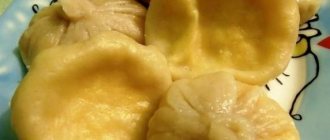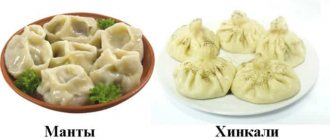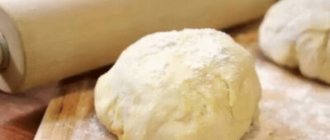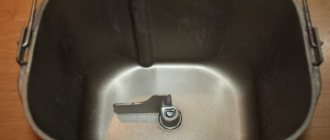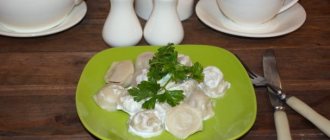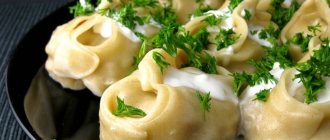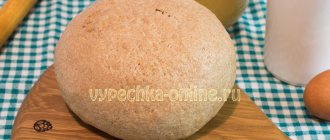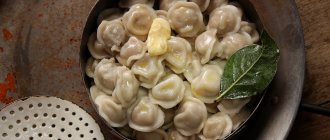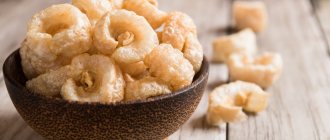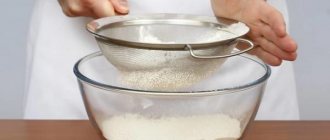There are dishes that everyone knows, but few people know what they should be. These include the famous Georgian khinkali, which for most residents of the post-Soviet space have become a type of dumplings and manti. There are similarities between them, but if they are properly prepared, served, and eaten, then these are completely different dishes that have their own taste qualities that cannot be confused with anything else.
Legends of scalding “bags”
Probably, no dish on earth has as many versions of origin as khinkali. One of the most common stories is as follows: during the war between Georgia and Persia in the 18th century, there were a lot of wounded soldiers who, for various reasons, could not eat solid food. Then the housewives in the mountains had practically nothing except sheep, flour and eggs, so they came up with one simple dish that helped save many lives. Tender and soft khinkali with aromatic broth inside were born.
The most interesting story about khinkali explains why ideal bags should have exactly 28 folds, no more and no less. It's all about the sacred meaning of the number 28 (the Sun passes through the great circle of the celestial sphere in 28 days). In ancient times, Georgians used a time system that was different from the modern one: they had 13 months a year, each of which consisted of 28 days, for a total of 364 days. The logic of this people was simple and laconic: the tail of the khinkali is the sun, and the 28 folds around are the days of the solar cycle.
Another version about the origin of this dish comes from historians. They believe that the ancestors of Khinkali were originally the ancient ethnic group Pshuari, thanks to which the dish began to spread far from its habitat. Pshuari added mint to khinkali, which gave them an incredible aroma and special piquancy.
In Georgia, they believe that the birthplace of everyone’s favorite national dish is the village of Pasanauri, which is located on the way to Kazbegi. There you will find completely different bags - very fatty and small, but (to the point of losing gastronomic consciousness) very tasty!
How to sculpt
The best way to work with the dough is to form a sausage, cut it into slices, and then roll them out into circles. At the same time, try to make the edges thinner than the middle. This will make the tail more neat. Place a spoonful of filling in the center of the dough and begin to form a bag. To do this, we pull one side of the edge to the center, then fold by fold in a circle we bring all the edges together until we get a “lush skirt”. The “waist” needs to be pinched well with your fingers. You can trim the edge of the dough - it will be more beautiful, or leave it - it will be more satisfying.
Types of khinkali
Despite all the severity of the above words, this dish has its own variations in different regions and cities of Georgia. If you go to Tbilisi, then most likely you will be served Kalakuri khinkali - with meat and herbs. It is also possible that you will find bags of potatoes, mushrooms and minced meat on the menu. This is also acceptable (but you remember about the perfect khinkali with minced meat). In Samegrelo, Adjara and Guria you are unlikely to find the same dish, because it is not customary to cook it there. But in Kakheti and Mtskheta-Mtianeti you can order countless bags and enjoy the amazing taste!
So that you do not get confused about the types of khinkali that rich Georgian cuisine offers, remember the most basic ones:
- khinkali “Kalakuri” - with meat/minced meat and herbs;
- khinkali “Mtialuri” - with meat/minced meat, but without greens;
- Kakhetian khinkali - only with pork;
- beef khinkali.
How to cook
In water. Molded khinkali are often boiled in water - this is a classic preparation. A saucepan or slow cooker is suitable for this. You need to throw them into well-boiling water, which has been previously salted. If the khinkali is from a store, or with a quickly prepared filling, for example, with cheese, vegetables or herbs, then after boiling the water again, you need to cook it for about 10 minutes. If they are hand-made, and also if chopped meat was added to the filling, then it is better to cook for about 20 minutes. As soon as everything is prepared and you catch them, be sure to rinse them with cold boiled water, and then grease the dough with vegetable or butter so that they do not stick together.
For a couple. To do this, you can use a multicooker, pressure cooker, or any type of double boiler. This way you can prepare both frozen and freshly prepared khinkali. During cooking, the dough softens and becomes sticky. To prevent the bag from perforating and all the juice from leaking out, grease the outside of the dough with vegetable oil. Also leave a distance of at least a centimeter between them. If you choose the steamed option, it is better to cook them for at least 30 minutes. This way the khinkali will have time to gain juiciness and cook thoroughly.
In the oven. Baked khinkali can be made in the oven. Grease a baking sheet with vegetable oil, and place the khinkali on it at a short distance from each other. Preheat the oven to 190 degrees, place a baking sheet in it, and pour a glass of water into the bottom. Bake for about 35-40 minutes.
In a frying pan. If you want to cook fried khinkali, there are two cooking options. Since the filling bags are quite large, it is better to boil them in advance and then let them dry for 10 minutes. Only after this can they be sent to the frying pan. If the bags are small, you can immediately fry them over high heat, and then add a little water, cover and simmer over low heat for about 10 minutes.
How to eat khinkali (set of rules)
From an early age, Georgians are taught to eat this traditional dish according to the rules. In the same way, local residents instruct guests of their country on the “true path” in eating khinkali. Remember the most important thing: the only thing that complements them is black pepper. No sauces, much less bread, are needed. Here's what else you need to know when you face the bag one on one:
- do not rush into the dish right away - it is very hot (let it cool for a couple of minutes, no more);
- pepper generously;
- do not eat khinkali with a fork, otherwise the thin dough will simply tear;
- take the bag by the tail and hold it from below;
- bite off some dough and drink the broth;
- You can put the khinkali in your mouth completely or bite off a little;
- do not eat the tail - this is not customary;
- never try already cold khinkali (they simply cease to be edible), it is better to ask them to fry. Fried khinkali is a completely separate and no less tasty dish.
Remember that tails are not eaten? There was a funny story associated with this, or perhaps someone just made up a joke. Once during his visit to Georgia, Nikita Sergeevich Khrushchev tasted real khinkali. He, like any other guest, was taught how to eat this dish correctly and warned that the tails were thrown away. Comrade Khrushchev, as a great rationalizer, could not come to terms with such a shock, because khinkali are made from the highest quality flour. He also quickly estimated that all of Georgia consumes 250 million khinkali per year, which means they throw away more than a ton of precious flour. After this, Georgia no longer saw premium flour. The times of Khrushchev are over, so you can safely go to the sunny country for the most delicate khinkali!
Tags: Gastronomic specialties Gastronomic tourism Georgian cuisine Georgia Articles
How to knead the right dough
The most reliable way is ready-made dough from the store. Not all good housewives know how to knead dough correctly. It doesn’t always work out, it often breaks and can ruin the dish. With the store-bought version there will be no such mistake, and the dish will still be prepared by you. You shouldn’t shy away from this method, because in Georgia itself, restaurants have a special master to prepare the dough, because it takes years of working with the dough to perfect the technique. The ideal option would be dough for khinkali and manti already cut into portioned mugs. But you can use dough for chebureks - the diameter will also suit you.
If you still decide to do everything yourself, then the classic dough recipe is as follows:
- Flour - - 3 cups + additional flour for rolling;
- Water – 1 glass;
- Salt – a big pinch.
The dough needs to be kneaded stiff, it needs to be kneaded well, and be sure to give it an hour so that the flour disperses well. Otherwise, this process is called “letting the dough rest.” Only after this can you begin rolling and sculpting.
On the Internet you can find recipes for dough made with kefir, beer, yeast, eggs, corn flour, and so on. To surprise guests, cuttlefish ink is added to the dough to create black khinkali. But the correct base for the dough is salt, water and flour.
How to store
Usually khinkali is prepared for one meal. While they are hot and just steaming, they are the juiciest and most delicious. If you couldn’t eat everything, you can store them in the refrigerator, but no more than a day. Make sure that the edges do not dry out - put the remainder in a pan or wrap with cling film.
If you have made much more khinkali than the serving portion, you can freeze them. The taste will not deteriorate much, but they may dry out a little. So it’s also better not to store them in the freezer for a long time. If they are well packaged and have not been defrosted, they can last up to 3 months.
Forget about ponytails
Khinkali is not only tasty, but also a very technically thought-out dish. Khinkali tails are made in such a way that it is possible to grasp and hold the khinkali in your hand. But don’t forget: 10-15 minutes is enough for the khinkali itself to be prepared, but for a thick tail it takes much more time, so very often the dough is not cooked there and eating the tails is highly not recommended. And one more argument in favor of this: since the dish is eaten without any cutlery, eating a place that a person touches with his hands is considered simply unhygienic by Georgians.
Georgian Khinkali (with photo)
The requirements for the form and content of classic khinkali are quite strict. Firstly, only lamb or goat meat can be used for the filling, secondly, the size of the khinkali must correspond to a walnut, and thirdly, there must be at least twenty folds in the dough. Fortunately, the modern approach to preparing this dish has changed somewhat and has become much softer. Therefore, read how to cook khinkali in Georgian, and feel free to get down to business.
- Sift one glass of flour through a sieve, pour half a glass of ice water into it, add salt and a spoonful of vegetable oil. Knead the dough, cover it with a towel and leave for half an hour.
- Chop 150 grams of lamb (can be replaced with lean pork) and 150 grams of beef with a knife. Add finely chopped onions, salt and water. The minced meat should be homogeneous in composition and quite elastic.
- Pour another glass of sifted flour into the dough and knead everything together for about ten minutes. After this, leave it for another half hour under the cloth. When the required time has passed, the dough should be divided into several parts.
- Roll out each piece thinly on the table with a rolling pin, and then cut out circles with a diameter of 15 cm.
- Place one and a half tablespoons of minced meat in the center of each circle. Using both hands, form the dough into a pouch, pinching the edges at the top.
- Boil one and a half liters of water in a saucepan, place the khinkali in it and cook until fully cooked. The result is such beauty as in the photo below.
Ingredients
for dough without eggs:
- wheat flour – 500 g
- salt – 1 tsp.
- ice water – 250 ml
- sunflower oil – 2 tbsp. l.
For filling:
- beef – 300 g
- pork – 300 g
- onions – 200 g
- garlic - 2 teeth.
- ground thyme – 1 chip.
- dried cumin - 1 chip.
- hops-suneli – 0.5 tsp.
- salt – 1 tsp. incomplete
- ground black pepper – 0.5 tsp.
- cilantro – 1 bunch.
- warm water – 100 ml
Tips from chefs
To facilitate the process of pinching khinkali, you should place a piece of dough between your index and thumb, connected into a ring. Then the minced meat is laid out on the flatbread, which is “pressed into the hole between the fingers - the fingers themselves need to be squeezed and the bag of the desired shape will be ready.
In the process of boiling Georgian khinkali, experienced chefs:
- It is not recommended to stir them with a slotted spoon or spoon, as they can damage the dough shell
- To prevent khinkali from sticking to the bottom, you just need to shake the pan periodically while holding its lid.
After the khinkali are ready, pour a glass of cold water into the pan with them - it will lower the temperature a little and allow you to eat the finished dish with your hands. Remove the khinkali from the pan using a slotted spoon, after which they are sprinkled with ground black pepper, poured over melted butter and served.
Making the filling
The taste of the prepared dish depends on what you wrap. Correctly following the recommendations will help you achieve a high-quality result; often the first time, cooking is done step by step while watching a video. You can make khinkal filling from lamb, pork or beef. We recommend fresh meat without veins, their presence will spoil the impression due to inconvenience when chewing.
It is customary to chop meat with a knife; to facilitate the process, you can load it into the freezer for a while. After this, it will be easy to cut it into small cubes. Using a meat grinder will make the task easier, but then the largest grate should be selected.
Preparing the filling consists of the following steps:
- adding onion, salt, pepper, thyme and cumin to the meat cubes;
- squeezing garlic;
- adding finely chopped cilantro (can be replaced with parsley);
- marinating for half an hour (so that the meat is saturated with herbs and spices).

